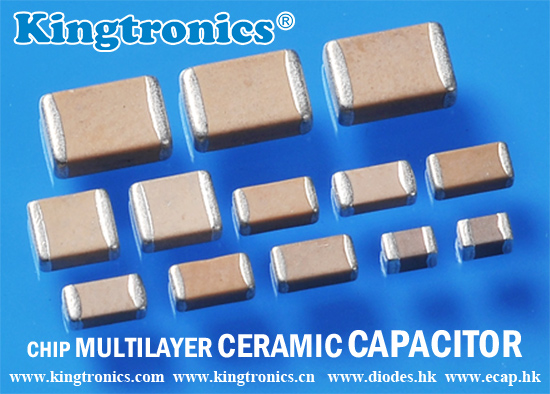Issues to Consider when using MLCC Capacitors
24 Jan 2011Multi-layer ceramic chip (MLCC) capacitors are used quite often in dc-dc converter input and output filters. They have low ESR, low ESL, and low cost. They also have no major reliability problems associated with them. All these properties make them suitable for power management applications. There are still, however, some issues to consider when using these capacitors in dc-dc converter circuits. Some ceramic capacitors can lose a lot of their value under certain conditions. This lost capacitance can degrade the transient response of a dc-dc converter, or it can even make the control loop of the converter unstable.
The capacitance per unit volume of the X7R/X5R dielectrics has increased quite a bit in the past few years. However, you should be careful about using the components with the highest capacitance densities. These capacitors lose a lot of their value at the higher frequencies where most dc-dc converter circuits operate. They lose even more capacitance when dc bias is applied to them.
Kingtronics specializes in application specific multilayer ceramic capacitors. Our product offerings included surface mount capacitors from the 0402 case size to larger high voltage units (up to 4KV) for Commercial and High Reliability applications.
- 0Commentary
- Tags:
Ceramic chip capacitors should be stored in normal working environments. While the chips themselves are quite robust in other environments, solder ability will be degraded by exposure to high temperatures, high humidity, corrosive atmospheres, and long term storage. In addition, packaging materials will be degraded by high temperature – reels may soften or warp, and tape peel force may increase. Kingtronics International Company recommends that maximum storage temperature not exceed 40℃, and maximum storage humidity not exceed 70% relative humidity. In addition, temperature fluctuations should be minimized to avoid condensation on the parts, and atmospheres should be free of chlorine and sulfur bearing compounds. For optimized solder ability, chip stock should be used promptly, preferably within 1.5 years of receipt
- 0Commentary
- Tags:
Kingtronics offers Chip Multilayer Ceramic Capacitors from low voltage (LKT)to high voltage(HKT)
5 Jan 2011A capacitor is a passive electronic component consisting of a pair of conductors separated by a dielectric.
Kingtronics specializes in application specific multilayer ceramic capacitors. Our product offerings included surface mount capacitors from the 0402 case size to larger high voltage units (up to 4KV) for Commercial and High Reliability applications.
The NPO model from Kingtronics International Company is a series of multilayer chip-type ceramic capacitors that has 0.5pF to 10uF capacitance, with up to 10 percent tolerance.
The 0805-packaged MLCC is rated at 6.3V to 50V for low voltage chip ceramic capacitor and from 63V to 4kV for high voltage multilayer ceramic capacitor.
Our products LKT Chip multilayer ceramic capacitors 6.3V to 50V and HKT High voltage multilayer ceramic capacitors 63V to 4000V are marketed under our own brand "Kingtronics" and enjoy a very good reputation around the world. Many customers approved our product brand "Kingtronics" and appointed to order.
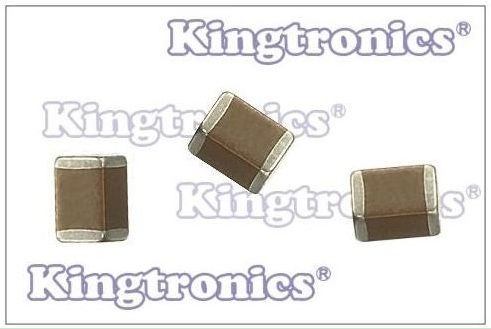
- 0Commentary
- Tags:
Kingtronics is one HK based manufacturer for electronics component since 1990. Now Kingtronics is an old brand and we also have enjoyed high reputation in electronics component field, especially for radial and axial multilayer ceramic capacitor!
Now fewer and fewer factories produce radial & axial lead mono capacitors, while Kingtronics still keep strong on radial multilayer ceramic capacitors and axial lead,
We have excellent support on radial MLCC capacitor,
***3-4 weeks delivery
***unbeatable price
***stable and high quality
***low MOQ
In case you have any inquiry for radial and axial multilayer ceramic capacitor, please feel free to contact us: info@kingtronics.com
MKT--Radial multilayer ceramic capacitor (mono cap)
0.1uF 50V Y5V +/-20% P:2.54mm Bulk RoHS
4700pF 50V +/-10% X7R P: 2.54mm Bulk RoHS
100pF 50V NPO +/-5% P: 2.54mm Bulk RoHS
AKT--axial lead, multilayer ceramic capacitors
0.1uF 50V +80-20% Y5V Ammo RoHS
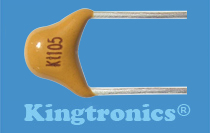
- 0Commentary
- Tags:
Multilayer ceramic capacitors
15 Dec 2010Multilayer ceramic capacitors consist of electrodes, the interleaved ceramic dielectric and the external terminal connectors. The capacitance is given by the description:

A = Electrode area
n = Number of active layers
d = Distance between electrodes
εr = Dielectric relative
ε0 = Dielectric constant
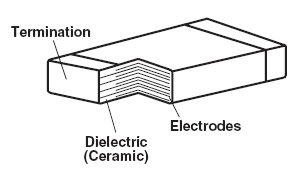
Whilst the values “A x n” and “d” are respectively determined by the production process the dielectric constant is a function of the ceramic material used.
- 0Commentary
- Tags:
Kt Kingtronics Ceramic Dielectrics
11 Dec 2010Ceramic capacitors have a variety of different ceramic dielectrics as the basis of the capacitor. Ceramic dielectrics are made from a variety of forms of ceramic dielectric. The exact formulas of the different ceramics used in ceramic capacitors vary from one manufacturer to another but common compounds include titanium dioxide, strontium titanate, and barium titanate.
The actual performance of the ceramic capacitors is highly dependent upon the dielectric used. Using modern dielectrics, very high values are available, but it is also necessary to check parameters such as the temperature coefficient and tolerance. Different levels of performance are often governed by the dielectric used, and therefore it is necessary to choose the type of dielectric in the ceramic capacitor.
Kingtronics www.kingtronics.com produce and sell Ceramic Capacitors all types. Multilayer Ceramic Capacitors are available in four series in Kingtronics: AKT Series Axial Lead, Axial MLCC Capacitors(Multilayer Ceramic Capacitors), MKT Series Radial MLCC Capacitors(Multilayer Ceramic Capacitors), LKT Series Chip MLCC.
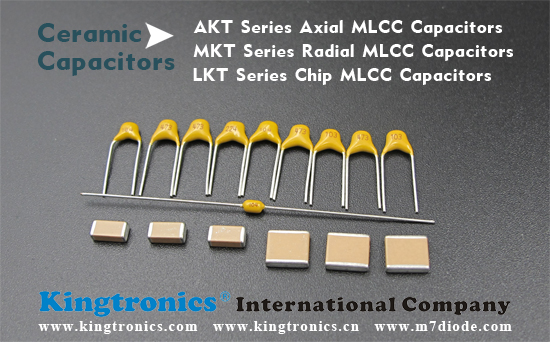
Kt Kingtronics Tells You What is Mono Capacitor?
22 Nov 2010"Mono" refers to a "monolithic" or "multilayer" capacitor. This just refers to the manufacturing process whereby the capacitor is formed by binding multiple, thin sheets of ceramic on which electrodes have been painted.
As the ceramic material technology continues to advance, more and more capacitance is realized in the same case sizes compared to previous years. Kingtronics produce and sell ceramic capacitors all types. Multilayer ceramic capacitors are available in four series in Kingtronics: AKT Series Axial Lead, Axial MLCC Capacitors(Multilayer Ceramic Capacitors), MKT Series Radial MLCC Capacitors(Multilayer Ceramic Capacitors), LKT Series Chip MLCC Capacitors(Multilayer Ceramic Capacitors) (6.3V to 50V), and HKT Series High Voltage MLCC Capacitors(Multilayer Ceramic Capacitors) (63VDC to 4000VDC).

Multilayer Ceramic Capacitor (MLCC) are widely used electronic components that temporarily store electrical charge. As the most common type of capacitor today, MLCCs have evolved with the advancements in technology to meet the growing demand for miniaturization in modern electronics.
These capacitors are crucial in powering smaller devices such as cell phones, computers, digital still cameras (DSC), digital video cameras (DVC), and GPS systems—all of which require compact, high-performance components.
Kingtronics MLCC Capacitors: Unbeatable Quality and Value
In addition to chip MLCC capacitors, Kingtronics offers a superior range of radial MLCC capacitors (mono capacitors) that stand out in the market. Our radial MLCC capacitors are renowned for their:
-
Competitive Pricing: Providing excellent value without compromising on quality.
-
High Quality: Manufactured to the highest standards for reliable performance.
-
Short Lead Times: Fast delivery to meet your production needs.
Kt Kingtronics MLCC and Ceramic Casting Films
16 Oct 2010Mitsubishi Polyester Film offers a complete portfolio of film products to support the worldwide Mono Capacitors and ceramic casting markets. Hostaphan® polyester film is approved for use in high end ceramic applications as a release liner. Hostaphan® film is the leading choice of polyester film for ceramic casting world wide. The Hostaphan® product delivers the following superior product attributes:
- Extremely smooth surface
- Optimized shrinkage
- Superior handling characteristics
- Chemical resistance
- Excellent flatness
- Ultra thin, highly cured coatings
- Controlled static levels
- Manufactured in a clean environment
Mitsubishi Polyester Film products are typically used in electronics applications. Hostaphan® polyester film product categories for ceramic casting film are as follows:
- Ceramic substrates
- Solvent based multilayer ceramic capacitors (MLCC)
- Water based multilayer ceramic capacitors (MLCC)
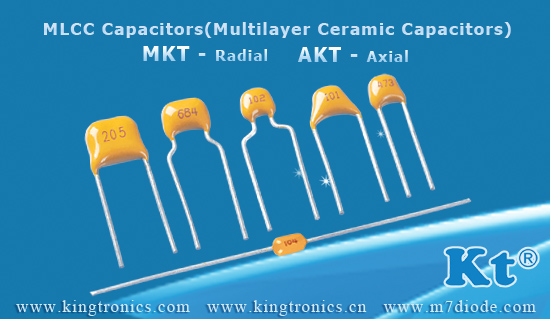
Kt Kingtronics Showa Denko to Expand Production Capacity for Titanium Oxide Nanoparticles
16 Oct 2010Showa Denko Expands Nanoparticle Titanium-Oxide Production Capacity for MLCC Capacitors
Tokyo, Oct 13, 2010 (JCN Newswire via COMTEX) -- Showa Denko K.K. (SDK) is set to expand its nanoparticle titanium-oxide production capacity at its wholly owned subsidiary, Showa Titanium Co., Ltd. The production capacity will increase from 180 tons per month to 240 tons per month starting in June 2011. The titanium oxide product, sold under the trade name Super-Titania(TM), is crucial in the production of multilayer ceramic capacitors (MLCC Capacitors).
What are MLCC Capacitors?
MLCC Capacitors are essential components in electronic devices that require compact size and light weight, such as PCs, mobile phones, and flat-panel TVs. Due to the increasing demand for these devices, the MLCC market is projected to grow at a rate of around 10% annually.
Production Expansion to Meet Growing Demand
To accommodate the rising demand, Showa Titanium will enhance the efficiency of its Super-Titania production facilities for MLCC applications. The number of production lines will increase from three to four, ensuring better capacity to meet market needs.
The Role of Titanium Oxide in MLCC Capacitors
Titanium oxide (TiO2) plays a critical role in producing barium titanate (BaTiO3), a key raw material for the dielectric component in MLCC Capacitors. Fine-particle TiO2 is essential for the solid-phase process, which enables the low-cost production of BaTiO3 with superior dielectric properties. Showa Titanium uses advanced process control technologies to produce Super-Titania in ultra-fine particle sizes ranging from 15 to 250 nm, ensuring high purity for MLCC Capacitors that are smaller and have higher capacity.
Applications Beyond MLCCs
While Super-Titania is primarily used in MLCC Capacitors, it also serves various other applications such as fillers and photocatalysts. Showa Titanium aims to provide high-quality, stable products to meet the diverse needs of customers, reinforcing its position as a market leader.
What is Dielectric?
Dielectric is a material that acts as an electrical insulator, capable of storing and instantly discharging electricity. As dielectric properties improve, the material's ability to store electricity increases.
Solid-phase vs. Liquid-phase Processes
There are two main processes for producing fine ceramics, including BaTiO3: the solid-phase and liquid-phase processes. The solid-phase process involves mixing materials and baking them at high temperatures, resulting in compound synthesis through chemical reactions. In the liquid-phase process, materials are dissolved in a solution, undergo chemical reactions, and then are baked at lower temperatures to form compounds.
Contact us
Tel: (86) 769 8118 8110
Tel: (852) 8106 7033
Fax: (852) 8106 7099
E-mail: info@kingtronics.com
Skype: kingtronics.sales
Web: www.Kingtronics.com
YouTube: www.youtube.com/c/Kingtronicskt
About
Kingtronics International Company was established in 1995 located in Dongguan City of China to handle all sales & marketing for factories located in Chengdu, Sichuan and Zhaoqing, Guangdong, China. In 1990, we established the first factory to produce trimming potentiometer and in 1999 we built up new factory in Zhao Qing, Guangdong. Now with around 850 workers, Kingtronics produce trimming potentiometers, dipped tantalum capacitors, multilayer ceramic capacitors, and diode & bridge rectifier. We sell good quality under our brand Kingtronics, and Kt, King, Kingtronics are our three trademarks. All our products are RoHS compliant, and our bridge rectifier have UL approval. Please visit our Products page, you could please download all our PDF datasheet and find cross reference for our Trimming Potentiometer and capacitors.
Tantalum and Ceramic Capacitors Cross Reference ↓ Download
Diodes & Rectifiers List(PDF: 97KB) ↓ Download
Trimming Potentiometer Cross Reference ↓Download
Categories
- Kt Kingtronics (245)
- Diodes & Rectifiers (161)
- Aluminum Electrolytic Capacitor (161)
- Trimming Potentiometers (128)
- Tantalum Capacitors (96)
- Multilayer Ceramic Capacitors (70)
- Quartz Crystals (64)
- Kt Bridge Rectifier (64)
- Surge Arresters (34)
- Film Capacitors (34)
- Tactile Switches (32)
- Kt Kingtronics Components (30)
- Ceramic Trimmer Capacitors (26)
- Super Capacitors (18)
- Metal Oxide Varistor (12)
- Negative Temperature Coefficient Thermistor (6)
- Special Purpose Film Capacitors (3)
- Music capacitors (2)
Archives
- 2025 March (3)
- 2025 February (3)
- 2025 January (4)
- 2024 December (2)
- 2024 November (5)
- 2024 October (4)
- 2024 September (6)
- 2024 August (9)
- 2024 July (6)
- 2024 June (5)
- 2024 May (3)
- 2024 April (3)
- 2024 March (2)
- 2024 February (2)
- 2024 January (3)
- 2023 December (1)
- 2023 November (2)
- 2023 October (1)
- 2023 September (2)
- 2023 August (2)
- 2023 July (4)
- 2023 June (12)
- 2023 May (6)
- 2023 April (4)
- 2023 March (3)
- 2023 February (2)
- 2023 January (1)
- 2022 December (3)
- 2022 November (2)
- 2022 October (3)
- 2022 September (4)
- 2022 August (3)
- 2022 July (3)
- 2022 June (2)
- 2022 May (3)
- 2022 April (4)
- 2022 March (4)
- 2022 February (2)
- 2022 January (3)
- 2021 December (4)
- 2021 November (3)
- 2021 October (4)
- 2021 September (4)
- 2021 August (4)
- 2021 July (4)
- 2021 June (5)
- 2021 May (4)
- 2021 April (3)
- 2021 March (4)
- 2021 February (4)
- 2021 January (4)
- 2020 December (5)
- 2020 November (4)
- 2020 October (4)
- 2020 September (7)
- 2020 August (8)
- 2020 July (9)
- 2020 June (8)
- 2020 May (9)
- 2020 April (11)
- 2020 March (6)
- 2020 February (4)
- 2020 January (4)
- 2019 December (6)
- 2019 November (7)
- 2019 October (6)
- 2019 September (5)
- 2019 August (9)
- 2019 July (6)
- 2019 June (4)
- 2019 May (16)
- 2019 April (6)
- 2019 March (6)
- 2019 February (9)
- 2019 January (5)
- 2018 December (4)
- 2018 November (4)
- 2018 October (5)
- 2018 September (8)
- 2018 August (10)
- 2018 July (7)
- 2018 June (12)
- 2018 May (22)
- 2018 April (4)
- 2018 March (4)
- 2018 February (8)
- 2018 January (13)
- 2017 December (4)
- 2017 November (4)
- 2017 October (5)
- 2017 September (4)
- 2017 August (20)
- 2017 July (7)
- 2017 June (5)
- 2017 May (4)
- 2017 April (4)
- 2017 March (8)
- 2017 February (8)
- 2017 January (8)
- 2016 December (10)
- 2016 November (16)
- 2016 October (8)
- 2016 September (10)
- 2016 August (13)
- 2016 July (12)
- 2016 June (10)
- 2016 May (14)
- 2016 April (8)
- 2016 March (10)
- 2016 February (6)
- 2016 January (8)
- 2015 December (10)
- 2015 November (8)
- 2015 October (3)
- 2015 July (5)
- 2015 June (9)
- 2015 May (7)
- 2015 April (8)
- 2015 March (9)
- 2015 February (7)
- 2015 January (5)
- 2014 December (13)
- 2014 November (4)
- 2014 October (4)
- 2014 September (5)
- 2014 August (4)
- 2014 July (4)
- 2014 June (4)
- 2014 May (4)
- 2014 April (4)
- 2014 March (5)
- 2014 February (3)
- 2014 January (4)
- 2013 December (8)
- 2013 November (9)
- 2013 October (10)
- 2013 September (9)
- 2013 August (11)
- 2013 July (10)
- 2013 June (3)
- 2013 May (4)
- 2013 April (3)
- 2013 March (2)
- 2013 February (1)
- 2013 January (3)
- 2012 December (5)
- 2012 November (6)
- 2012 October (5)
- 2012 September (10)
- 2012 August (11)
- 2012 July (11)
- 2012 June (12)
- 2012 May (14)
- 2012 April (9)
- 2012 March (14)
- 2012 February (9)
- 2012 January (6)
- 2011 December (9)
- 2011 November (11)
- 2011 October (10)
- 2011 September (13)
- 2011 August (14)
- 2011 July (13)
- 2011 June (13)
- 2011 May (13)
- 2011 April (14)
- 2011 March (27)
- 2011 February (13)
- 2011 January (24)
- 2010 December (21)
- 2010 November (12)
- 2010 October (11)

